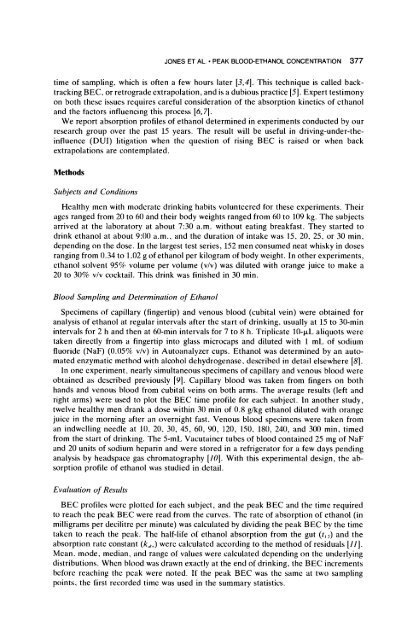Click Here for the PDF - Library
Click Here for the PDF - Library
Click Here for the PDF - Library
Create successful ePaper yourself
Turn your PDF publications into a flip-book with our unique Google optimized e-Paper software.
JONES ET AL.. PEAK BLOOD-ETHANOL CONCENTRATION 377<br />
time of sampling, which is often a few hours later [3,4]. This technique is called back-<br />
tracking BEC, or retrograde extrapolation, and is a dubious practice [5]. Expert testimony<br />
on both <strong>the</strong>se issues requires careful consideration of <strong>the</strong> absorption kinetics of ethanol<br />
and <strong>the</strong> factors influencing this process [6, 71.<br />
We report absorption profiles of ethanol determined in experiments conducted by our<br />
research group over <strong>the</strong> past 15 years. The result will be useful in driving-under-<strong>the</strong>-<br />
influence (DUI) litigation when <strong>the</strong> question of rising BEC is raised or when back<br />
extrapolations are contemplated.<br />
Methods<br />
Subjects and Conditions<br />
Healthy men with moderate drinking habits volunteered <strong>for</strong> <strong>the</strong>se experiments. Their<br />
ages ranged from 20 to 60 and <strong>the</strong>ir body weights ranged from 60 to 109 kg. The subjects<br />
arrived at <strong>the</strong> laboratory at about 7:30 a.m. without eating breakfast. They started to<br />
drink ethanol at about 9:00 a.m., and <strong>the</strong> duration of intake was 15, 20, 25, or 30 rain,<br />
depending on <strong>the</strong> dose. In <strong>the</strong> largest test series, 152 men consumed neat whisky in doses<br />
ranging from 0.34 to 1.02 g of ethanol per kilogram of body weight. In o<strong>the</strong>r experiments,<br />
ethanol solvent 95% volume per volume (v/v) was diluted with orange juice to make a<br />
20 to 30% v/v cocktail. This drink was finished in 30 min.<br />
Blood Sampling and Determination of" Ethanol<br />
Specimens of capillary (fingertip) and venous blood (cubital vein) were obtained <strong>for</strong><br />
analysis of ethanol at regular intervals after <strong>the</strong> start of drinking, usually at 15 to 30-min<br />
intervals <strong>for</strong> 2 h and <strong>the</strong>n at 60-rain intervals <strong>for</strong> 7 to 8 h. Triplicate 10-1~L aliquots were<br />
taken directly from. a fingertip into glass microcaps and diluted with 1 mL of sodium<br />
fluoride (NaF) (I).1)5% v/v) in Autoanalyzer cups. Ethanol was determined by an auto-<br />
mated enzymatic method with alcohol dehydrogenase, described in detail elsewhere [8].<br />
In one experiment, nearly simultaneous specimens of capillary and venous blood were<br />
obtained as described previously [9]. Capillary blood was taken from fingers on both<br />
hands and venous blood from cubital veins on both arms. The average results (left and<br />
right arms) were used to plot <strong>the</strong> BEC time profile <strong>for</strong> each subject. In ano<strong>the</strong>r study,<br />
twelve healthy men drank a dose within 30 min of 0.8 g/kg ethanol diluted with orange<br />
juice in <strong>the</strong> morning after an overnight fast. Venous blood specimens were taken from<br />
an indwelling needle at 10. 20, 30, 45, 60, 9(1, 120, 150, 180, 240, and 300 min, timed<br />
from <strong>the</strong> start of drinking. The 5-mL Vacutainer tubes of blood contained 25 mg of NaF<br />
and 20 units of sodium hcparin and were stored in a refrigerator <strong>for</strong> a few days pending<br />
analysis by headspace gas chromatography [10]. With this experimental design, <strong>the</strong> ab-<br />
sorption profile of ethanol was studied in detail.<br />
Evaluation of Results<br />
BEC profiles were plotted <strong>for</strong> each subject, and <strong>the</strong> peak BEC and <strong>the</strong> time required<br />
to reach <strong>the</strong> pcak BEC were read from <strong>the</strong> curves. The rate of absorption of ethanol (in<br />
milligrams per decilitrc pcr minute) was calculated by dividing <strong>the</strong> peak BEC by <strong>the</strong> time<br />
takcn to reach <strong>the</strong> peak. The half-life of ethanol absorption from <strong>the</strong> gut (t~2) and <strong>the</strong><br />
absorption rate constant (k.,h,) were calculated according to <strong>the</strong> method of residuals [11].<br />
Mean. mode, median, and range of values were calculated depending on thc underlying<br />
distributions. When blood was drawn exactly at <strong>the</strong> end of drinking, <strong>the</strong> BEC increments<br />
be<strong>for</strong>e reaching <strong>the</strong> pcak were noted. If <strong>the</strong> peak BEC was <strong>the</strong> same at two sampling<br />
points, <strong>the</strong> first recorded time was used in <strong>the</strong> summary statistics.

















